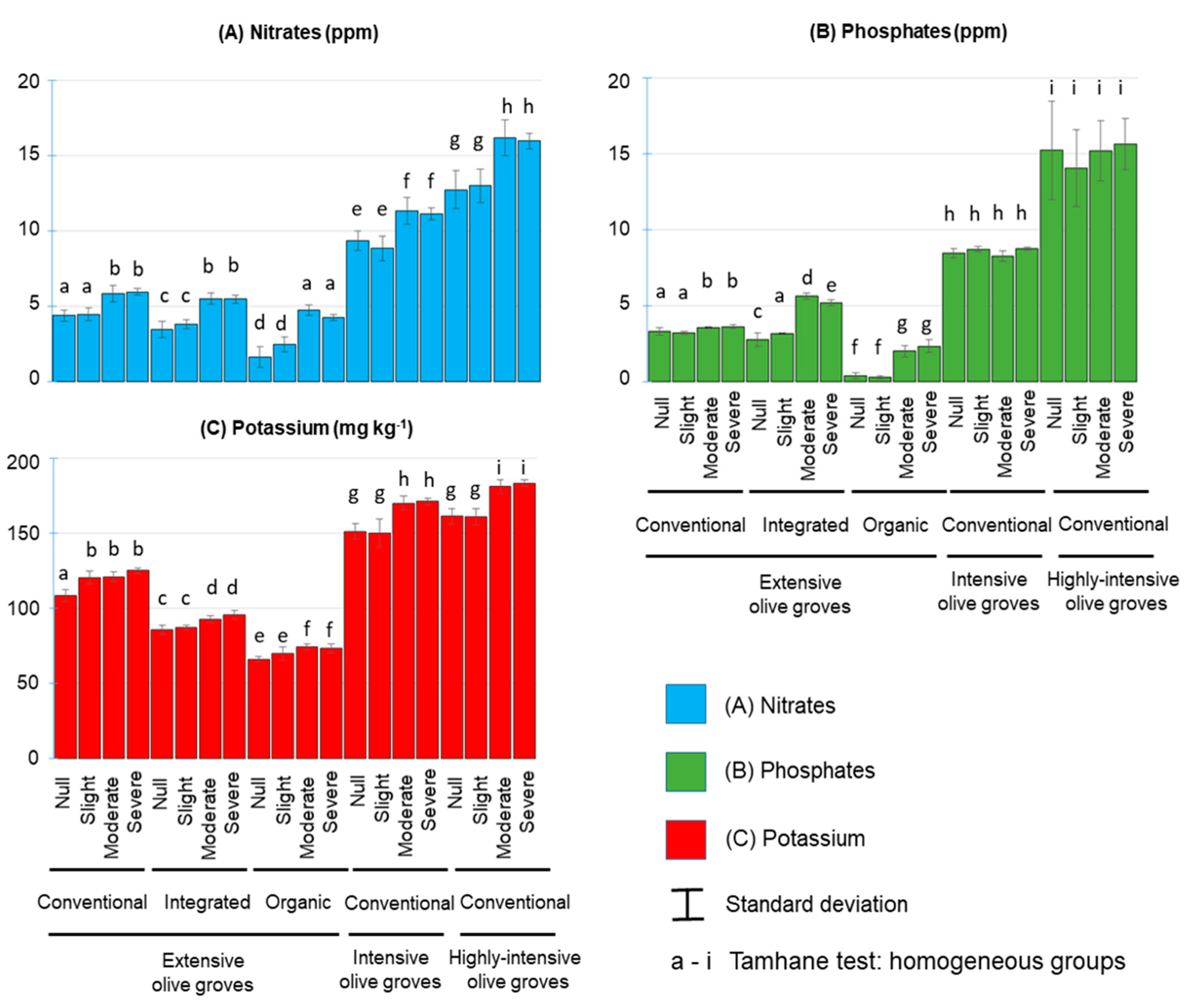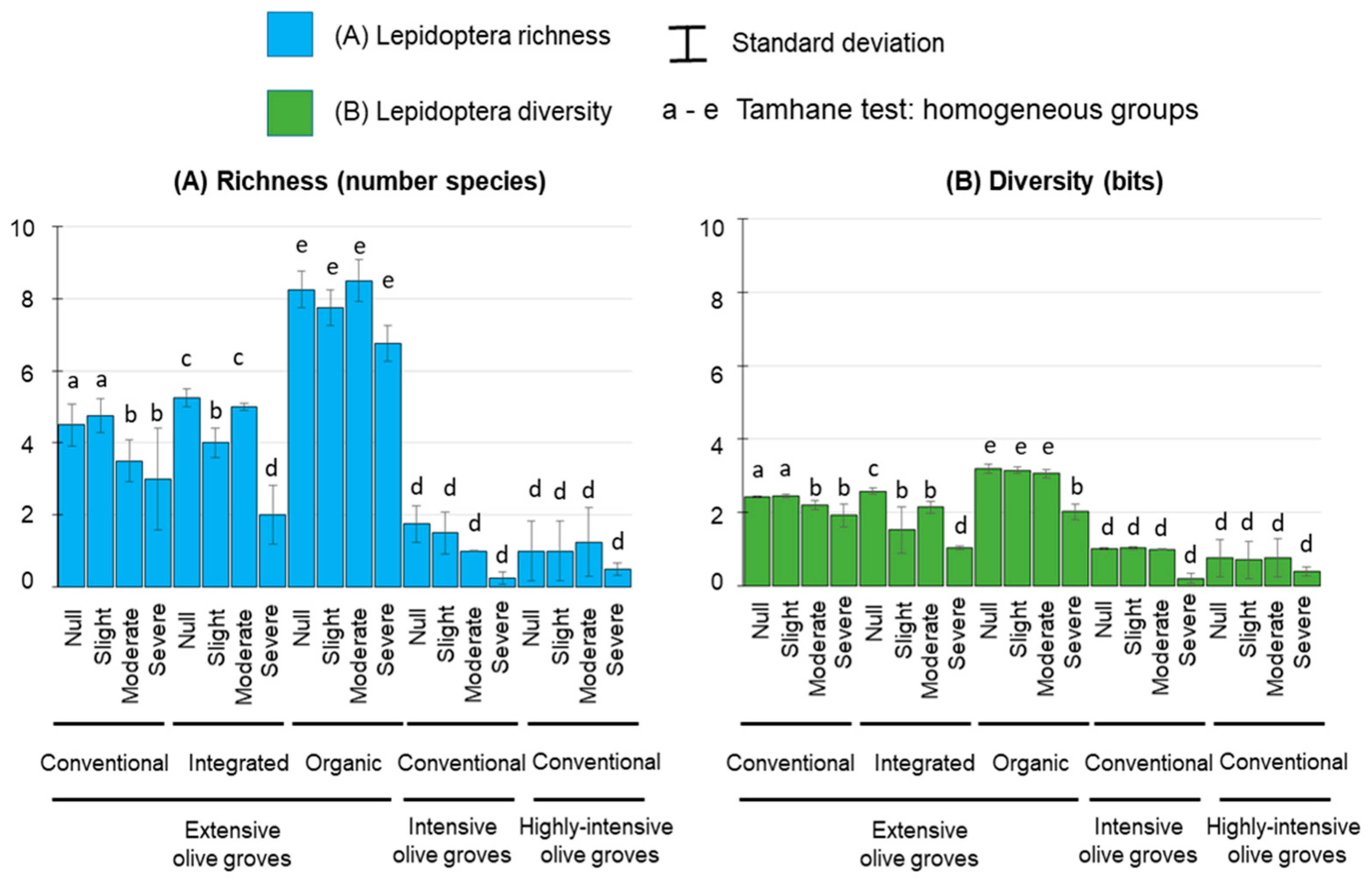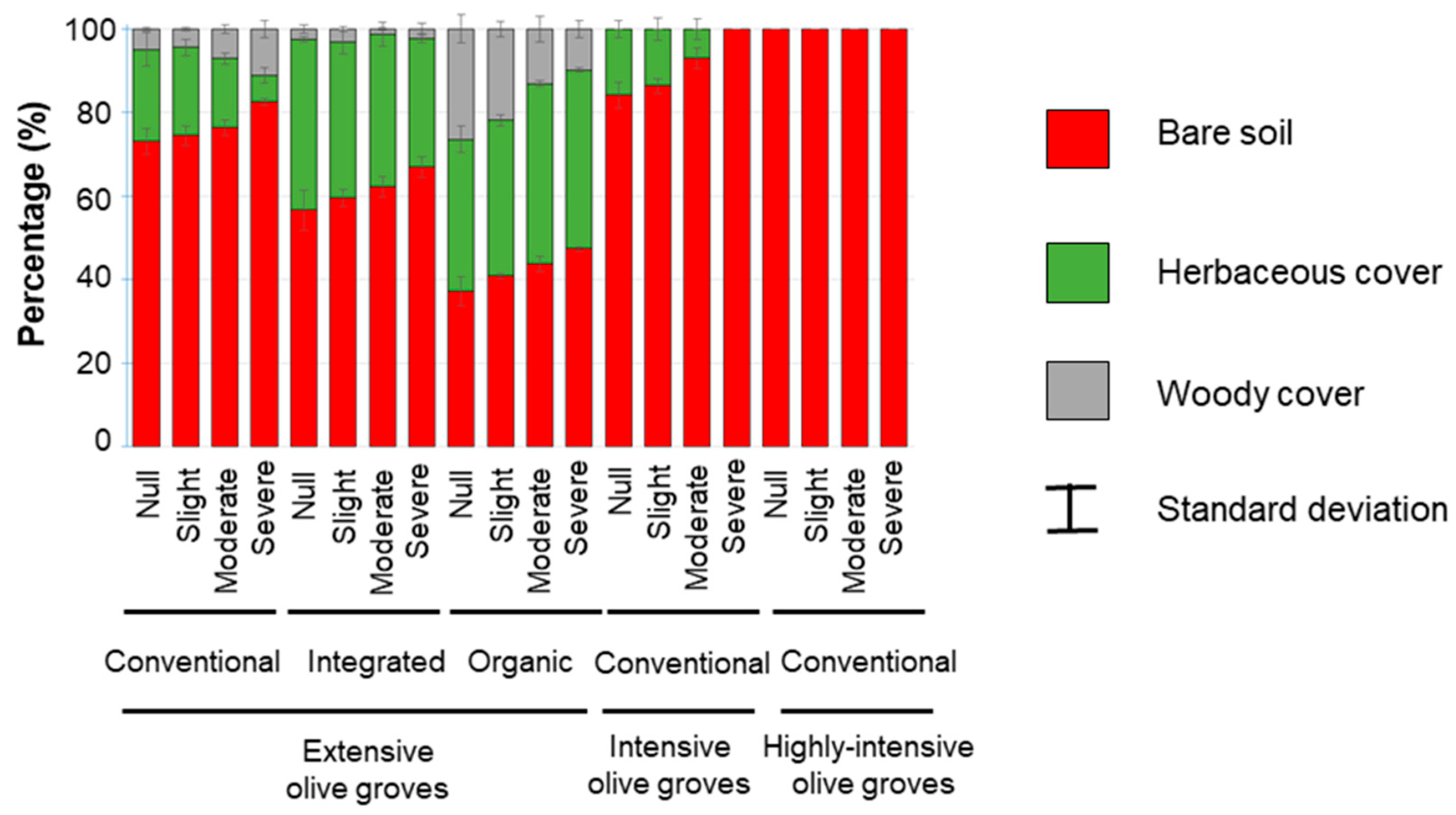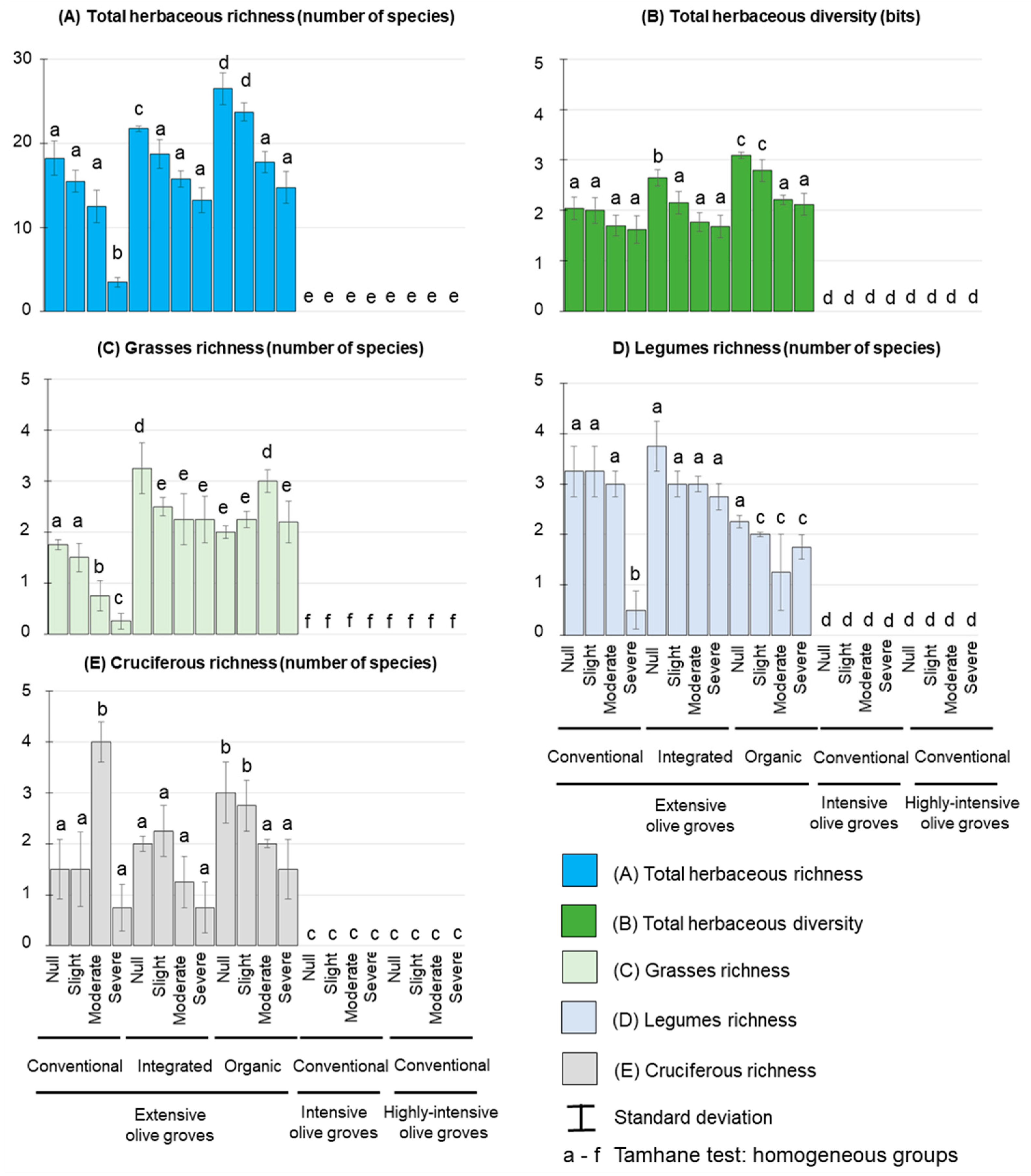Impacts of Fertilization on Environmental Quality across a Gradient of Olive Grove Management Systems in Alentejo (Portugal)
Abstract
:1. Introduction
2. Materials and Methods
2.1. Study Area
2.2. Experimental Design and Sample Collection
2.3. Statistical Analysis
3. Results
3.1. Agrochemical and Biological Indicators
3.1.1. Chemical Fertilizers
3.1.2. Lepidoptera Richness and Diversity
3.1.3. Soil Cover, Richness and Diversity
3.2. Impact of Chemical Fertilizers on the richness and Diversity of the Olive Grove
4. Discussion
4.1. Relationships between Chemical Fertilizer Use, Soil Erosion and Agricultural Intensification
4.2. Impact of Chemical Fertilizers on Fauna and Flora in Olive Groves
5. Conclusions
Supplementary Materials
Author Contributions
Funding
Institutional Review Board Statement
Informed Consent Statement
Data Availability Statement
Acknowledgments
Conflicts of Interest
References
- EUROSTAT. Farm Structure Statistics; Eurostat (European Statistics): Brussels, Belgium, 2018; Available online: https://ec.europa.eu/eurostat/statistics-explained/index.php?title=Farm_structure_statistics/es (accessed on 7 August 2022).
- Costa, A.; Madeira, M.; Santos, J.L.; Oliveira, Â. Change and dynamics in Mediterranean evergreen oak woodlands landscapes of Southwestern Iberian Peninsula. Landsc. Urban Plan. 2011, 102, 164–176. [Google Scholar] [CrossRef]
- Rodríguez-Entrena, M.; Colombo, S.; Arriaza, M. The landscape of olive groves as a driver of the rural economy. Land Use Policy 2017, 65, 164–175. [Google Scholar] [CrossRef]
- BOE. Ley 5/2011, de 6 de Octubre, del Olivar de Andalucía; Boletín Oficial del Estado/State Official Bulletin(BOE): Andalusia, Spain, 2011; Available online: https://www.boe.es/buscar/act.php?id=BOE-A-2011-17494 (accessed on 27 April 2021). (In Spanish)
- BOJA. Plan Director del Olivar Andaluz Decreto 103/2015; BOJA (Boletín Oficial de la Junta de Andalucía/Official Regional Government of Andalusia Bulletin): Sevilla, Spain, 2015; Available online: http://www.webcitation.org/77MO1YwQe (accessed on 20 August 2022). (In Spanish)
- INE. Anuário Estatístico da Região do Alentejo; INE (Instituto Nacional de Estadística en Portugal/National Institute of Statistics in Portugal): Lisbon, Portugal, 2012; Available online: https://www.ine.pt/xurl/pub/209571729 (accessed on 18 August 2022). (In Portuguese)
- Rodríguez Sousa, A.A.; Muñoz-Rojas, J.; Pinto-Correia, T.; Aguilera, P.A.; Barandica, J.M.; Rescia, A.J. A Comparative Analysis of Soil Loss Tolerance and Productivity of the Olive Groves in the Protected Designation of Origin (PDO) Areas Norte Alentejano (Portugal) and Estepa (Andalusia, Spain). Agronomy 2021, 11, 665. [Google Scholar] [CrossRef]
- Giourga, C.; Loumou, A.; Tsevreni, I.; Vergou, A. Assessing the sustainability factors of traditional olive groves on Lesvos Island, Greece (Sustainability and traditional cultivation). GeoJournal 2008, 73, 149–159. [Google Scholar] [CrossRef]
- Torres-Miralles, M.; Grammatikopoulou, I.; Rescia, A.J. Employing contingent and inferred valuation methods to evaluate the conservation of olive groves and associated ecosystem services in Andalusia (Spain). Ecosyst. Serv. 2017, 26, 258–269. [Google Scholar] [CrossRef]
- Rey, P.J.; Manzaneda, A.J.; Valera, F.; Alcantara, J.M.; Tarifa, R.; Isla, J.; Molina-Pardo, J.L.; Calvo, G.; Salido, T.; Gutiérrez, E.; et al. Landscape-moderated biodiversity effects of ground herb cover in olive groves: Implications for regional biodiversity conservation. Agric. Ecosyst. Environ. 2019, 277, 61–73. [Google Scholar] [CrossRef]
- COI. Cifras Aceite de Oliva; Consejo Oleícola Internacional/International Olive Council (COI): Madrid, Spain, 2015; Available online: http://www.internationaloliveoil.org (accessed on 26 April 2021). (In Spanish)
- Parras-Alcántara, L.; Lozano-García, B.; Keesstra, S.; Cerdà, A.; Brevik, E.C. Long-term effects of soil management on ecosystem services and soil loss estimation in olive grove top soils. Sci. Total Environ. 2016, 571, 498–506. [Google Scholar] [CrossRef]
- D’Auria, A.; Marano-Marcolini, C.; Čehić, A.; Tregua, M. Oleotourism: A comparison of three mediterranean countries. Sustainability 2020, 12, 8995. [Google Scholar] [CrossRef]
- Maniatakou, S.; Berg, H.; Maneas, G.; Daw, T.M. Unravelling diverse values of ecosystem services: A socio-cultural valuation using Q methodology in Messenia, Greece. Sustainability 2020, 12, 10320. [Google Scholar] [CrossRef]
- Di-Clemente, E.; Campón-Cerro, A.M.; Folgado-Fernández, J.A.; Hernández-Mogollón, J.M. Residents’ attitude and emotional response to Oleotourism: A case study of Extremadura (Spain). Tour. Recreat. Res. 2021, 1–14. [Google Scholar] [CrossRef]
- Duarte, F.; Jones, N.; Fleskens, L. Traditional olive orchards on sloping land: Sustainability or abandonment? J. Environ. Manag. 2008, 89, 86–98. [Google Scholar] [CrossRef]
- Ramón Guzmán-Álvarez, J.; Navarro-Cerrillo, R.M. Modelling potential abandonment and natural restoration of marginal olive groves in Andalusia (south of Spain). J. Land Use Sci. 2008, 3, 113–129. [Google Scholar] [CrossRef]
- de Graaff, J.; Duarte, F.; Fleskens, L.; de Figueiredo, T. The future of olive groves on sloping land and ex-ante assessment of cross compliance for erosion control. Land Use Policy 2010, 27, 33–41. [Google Scholar] [CrossRef]
- Isoni, A. The Common Agriculture Policy (CAP): Achievements and future prospects. In Law and Agroecology; Springer: Berlin/Heidelberg, Germany, 2015; pp. 185–206. [Google Scholar] [CrossRef]
- Mairech, H.; López-Bernal, Á.; Moriondo, M.; Dibari, C.; Regni, L.; Proietti, P.; Villalobos, F.J.; Testi, L. Sustainability of olive growing in the Mediterranean area under future climate scenarios: Exploring the effects of intensification and deficit irrigation. Eur. J. Agron. 2021, 129, 126319. [Google Scholar] [CrossRef]
- Tarifa, R.; Martínez-Núñez, C.; Valera, F.; González-Varo, J.P.; Salido, T.; Rey, P.J. Agricultural intensification erodes taxonomic and functional diversity in Mediterranean olive groves by filtering out rare species. J. Appl. Ecol. 2021, 58, 2266–2276. [Google Scholar] [CrossRef]
- Rodríguez-Lizana, A.; Ordóñez, R.; Espejo-Pérez, A.J.; González, P. Plant cover and control of diffuse pollution from P in olive groves. Wat. Air and Soil Poll. 2007, 181, 17–34. [Google Scholar] [CrossRef]
- Morgado, R.; Ribeiro, P.F.; Santos, J.L.; Rego, F.; Beja, P.; Moreira, F. Drivers of irrigated olive grove expansion in Mediterranean landscapes and associated biodiversity impacts. Landsc. Urban Plan. 2022, 225, 104429. [Google Scholar] [CrossRef]
- AEMO. Aproximación a los Costes del Cultivo del Olivo. Cuaderno de Conclusiones del Seminario AEMO; AEMO (Asociación Española de Municipios del Olivo/Spanish Association of Municipalities of Olive Groves): Córdoba, Spain, 2012; Available online: http://www.webcitation.org/77MCvuNPx (accessed on 19 August 2022). (In Spanish)
- Romero-Gámez, M.; Castro-Rodríguez, J.; Suárez-Rey, E.M. Optimization of olive growing practices in Spain from a life cycle assessment perspective. J. Clean Prod. 2017, 149, 25–37. [Google Scholar] [CrossRef]
- Pleguezuelo, C.R.R.; Zuazo, V.H.D.; Martínez, J.R.F.; Peinado, F.J.M.; Martín, F.M.; Tejero, I.F.G. Organic olive farming in Andalusia, Spain. A review. Agron. Sustain. Dev. 2018, 38, 20. [Google Scholar] [CrossRef]
- Rodríguez Sousa, A.A.; Parra-López, C.; Sayadi-Gmada, S.; Barandica, J.M.; Rescia, A.J. A multifunctional assessment of integrated and ecological farming in olive agroecosystems in southwestern Spain using the Analytic Hierarchy Process. Ecol. Econ. 2020, 173, 106658. [Google Scholar] [CrossRef]
- Palma, P.; Alvarenga, P.; Palma, V.; Matos, C.; Fernandes, R.M.; Soares, A.; Barbosa, I.R. Evaluation of surface water quality using an ecotoxicological approach: A case study of the Alqueva Reservoir (Portugal). Environ. Sci. Pollut. Res. 2010, 17, 703–716. [Google Scholar] [CrossRef] [PubMed]
- Palma, P.; Köck-Schulmeyer, M.; Alvarenga, P.; Ledo, L.; Barbosa, I.R.; De Alda, M.L.; Barceló, D. Risk assessment of pesticides detected in surface water of the Alqueva reservoir (Guadiana basin, southern of Portugal). Sci. Total Environ. 2014, 488, 208–219. [Google Scholar] [CrossRef] [PubMed]
- Proietti, P.; Nasini, L.; Reale, L.; Caruso, T.; Ferranti, F. Productive and vegetative behavior of olive cultivars in super high-density olive grove. Sci. Agric. 2015, 72, 20–27. [Google Scholar] [CrossRef] [Green Version]
- Carmo, M.; García-Ruiz, R.; Ferreira, M.I.; Domingos, T. The NPK soil nutrient balance of Portuguese cropland in the 1950s: The transition from organic to chemical fertilization. Sci. Rep. 2017, 7, 8111. [Google Scholar] [CrossRef] [Green Version]
- Sharma, N.; Singhvi, R. Effects of chemical fertilizers and pesticides on human health and environment: A review. Int. J. Agric. Environ. Biotechnol. 2017, 10, 675–680. [Google Scholar] [CrossRef]
- Metzidakis, I.; Martinez-Vilela, A.; Nieto, G.C.; Basso, B. Intensive olive orchards on sloping land: Good water and pest management are essential. J. Environ. Manag. 2008, 89, 120–128. [Google Scholar] [CrossRef]
- Carpio, A.J.; Castro, J.; Tortosa, F.S. Arthropod biodiversity in olive groves under two soil management systems: Presence versus absence of herbaceous cover crop. Agric. For. Entomol. 2019, 21, 58–68. [Google Scholar] [CrossRef]
- Kurze, S.; Heinken, T.; Fartmann, T. Nitrogen enrichment in host plants increases the mortality of common Lepidoptera species. Oecologia 2018, 188, 1227–1237. [Google Scholar] [CrossRef]
- Montanaro, G.; Xiloyannis, C.; Nuzzo, V.; Dichio, B. Orchard management, soil organic carbon and ecosystem services in Mediterranean fruit tree crops. Sci. Hortic. 2017, 217, 92–101. [Google Scholar] [CrossRef]
- Fraga, H.; Pinto, J.G.; Santos, J.A. Olive tree irrigation as a climate change adaptation measure in Alentejo, Portugal. Agric. Water Manag. 2020, 237, 106193. [Google Scholar] [CrossRef]
- Lourinho, G.; Brito, P. Assessment of biomass energy potential in a region of Portugal (Alto Alentejo). Energy 2015, 81, 189–201. [Google Scholar] [CrossRef]
- INE. Azeitona Oleificada (t) por Localização Geográfica (NUTS–2013); INE (Instituto Nacional de Estadística en Portugal/ National Institute of Statistics in Portugal): Lisbon, Portugal, 2022; Available online: https://www.ine.pt/xportal/xmain?xpid=INE&xpgid=ine_indicadores&userLoadSave=Load&userTableOrder=9286&tipoSeleccao=1&contexto=pq&selTab=tab1&submitLoad=true&xlang=pt (accessed on 20 August 2022). (In Portuguese)
- Oliveira-Baptista, F. Los asalariados agrícolas, el trabajo y los territorios: El caso portugués. Estud. Reg. 1992, 31, 31–44. (In Spanish) [Google Scholar]
- Morais, T.G.; Silva, C.; Jebari, A.; Álvaro-Fuentes, J.; Domingos, T.; Teixeira, R.F. A proposal for using process-based soil models for land use Life cycle impact assessment: Application to Alentejo, Portugal. J. Clean. Prod. 2018, 192, 864–876. [Google Scholar] [CrossRef]
- Islam, M.; Singh, B.; Dijkstra, F.A. Stabilisation of soil organic matter: Interactions between clay and microbes. Biogeochemistry 2022, 160, 145–158. [Google Scholar] [CrossRef]
- AEMO. Aproximación a los Costes del Cultivo del Olivo. Desarrollo y Conclusiones del Estudio AEMO actualizado a 2020; AEMO (Asociación Española de Municipios del Olivo/Spanish Association of Municipalities of Olive Groves): Córdoba, Spain, 2012; Available online: https://www.aemo.es/slides/slide/estudio-de-costes-aemo-2020-241/download (accessed on 11 August 2022). (In Spanish)
- Silveira, A.; Ferrão, J.; Munoz-Rojas Morenes, J.; Pinto-Correia, T.; Guimarães, M.H.; Schmidt, L. The sustainability of agricultural intensification in the early 21st century: Insights from the olive oil production in Alentejo (Southern Portugal). Chang. Soc. Legacies Chall. Divers. Worlds Sustain. 2018, 3, 247–275. [Google Scholar] [CrossRef]
- CORINE Land Cover. Copernicus Land Monitoring Service; CORINE Land Cover: Copenhagen, Denmark, 2022; Available online: https://land.copernicus.eu/pan-european/corine-land-cover (accessed on 5 August 2022).
- Epic WebGIS Portugal. Ecological Planning, Investigation and Cartography; Epic WebGIS Portugal: Lisbon, Portugal, 2021; Available online: http://epic-webgis-portugal.isa.ulisboa.pt/ (accessed on 17 August 2022).
- Wischmeier, W.H.; Smith, D.D. A universal soil-loss equation to guide conservation farm planning. Trans. Int. Congr. Soil Sci. 1960, 1, 418–425. Available online: https://www.cabdirect.org/cabdirect/abstract/19621901607 (accessed on 12 August 2022).
- Alewell, C.; Borrelli, P.; Meusburger, K.; Panagos, P. Using the USLE: Chances, challenges and limitations of soil erosion modelling. Int. Soil Water Conserv. Res. 2019, 7, 203–225. [Google Scholar] [CrossRef]
- Moreira-Madueño, J.M. Capacidad de uso y Erosión de Suelos. Una Aproximación a la Evaluación de Tierras en Andalucía; Junta de Andalucía (Andalusia Government): Seville, Spain, 1991; Available online: http://www.juntadeandalucia.es/medioambiente/web/Red_informacion_ambiental/productos/Publicaciones/articulos/articulos_pdf/Paralelo.PDF (accessed on 1 August 2022). (In Spanish)
- Gisbert Blanquer, J.M.; Ibañez Asensio, S.; Moreno Ramón, H. El Factor K de la Ecuación Universal de Pérdidas de Suelo (USLE); Universitat Politècnica de València: Valencia, Spain, 2012; Available online: http://hdl.handle.net/10251/16850 (accessed on 21 August 2022). (In Spanish)
- Wischmeier, W.H.; Johnson, C.B.; Cross, B.V. Soil erodibility nomograph for farmland and construction sites. J. Soil Water Conserv. 1971, 26, 189–193. [Google Scholar]
- Wischmeier, W.H.; Mannering, J.V. Relation of soil properties to its erodibility. Soil Sci. Soc. Am. J. 1969, 33, 131–137. [Google Scholar] [CrossRef]
- Gómez, J.A.; Battany, M.; Renschler, C.S.; Fereres, E. Evaluating the impact of soil management on soil loss in olive orchards. Soil Use Manag. 2003, 19, 127–134. [Google Scholar] [CrossRef]
- Russo, C.; Cappelletti, G.M.; Nicoletti, G.M.; Di Noia, A.E.; Michalopoulos, G. Comparison of European olive production systems. Sustainability 2016, 8, 825. [Google Scholar] [CrossRef] [Green Version]
- Foster, G.R.; Highfill, R.E. Effect of terraces on soil loss: USLE P factor values for terraces. J. Soil Water Conserv. 1983, 38, 48–51. [Google Scholar]
- Santisteban, L.D.; Casalí, J.; López, J.J.; Giráldez, J.V.; Poesen, J.; Nachtergaele, J. Exploring the role of topography in small channel erosion. Earth Surface Processes and Landforms. J. Br. Geomorphol. Res. 2005, 30, 591–599. [Google Scholar] [CrossRef]
- Cuoco, E.; Darrah, T.H.; Buono, G.; Verrengia, G.; De Francesco, S.; Eymold, W.K.; Tedesco, D. Inorganic contaminants from diffuse pollution in shallow groundwater of the Campanian Plain (Southern Italy). Implications for geochemical survey. Environ. Monit. Assess. 2015, 187, 46. [Google Scholar] [CrossRef] [PubMed]
- Adetunji, A.T.; Lewu, F.B.; Mulidzi, R.; Ncube, B. The biological activities of β-glucosidase, phosphatase and urease as soil quality indicators: A review. Soil Sci. Plant Nutr. 2017, 17, 794–807. [Google Scholar] [CrossRef] [Green Version]
- Duan, X.W.; Yun, X.; Feng, Y.J.; Yin, S.Q. Study on the method of soil productivity assessment in black soil region of Northeast China. Agric. Sci. China 2009, 8, 472–481. [Google Scholar] [CrossRef]
- Gómez, J.A.; Campos, M.; Guzmán, G.; Castillo-Llanque, F.; Vanwalleghem, T.; Lora, Á.; Giráldez, J.V. Soil erosion control, plant diversity, and arthropod communities under heterogeneous cover crops in an olive orchard. Environ. Sci. Pollut. Res. 2018, 25, 977–989. [Google Scholar] [CrossRef]
- Couëdel, A.; Alletto, L.; Tribouillois, H.; Justes, É. Cover crop crucifer-legume mixtures provide effective nitrate catch crop and nitrogen green manure ecosystem services. Agric. Ecosyst. Environ. 2018, 254, 50–59. [Google Scholar] [CrossRef]
- Repullo-Ruibérriz de Torres, M.A.; Ordóñez-Fernández, R.; Moreno-García, M.; Márquez-García, J.; Carbonell-Bojollo, R.M. Carbon sequestration by grass, crucifer and legume groundcovers in olive orchards. J. Water Clim. Chang. 2018, 9, 748–763. [Google Scholar] [CrossRef] [Green Version]
- Izsak, J. Parameter dependence of correlation between the Shannon index and members of parametric diversity index family. Ecol. Indic. 2007, 7, 181–194. [Google Scholar] [CrossRef]
- Van Swaay, C.A.; Nowicki, P.; Settele, J.; Van Strien, A.J. Butterfly monitoring in Europe: Methods, applications and perspectives. Biodivers. Conserv. 2008, 17, 3455–3469. [Google Scholar] [CrossRef]
- Gastwirth, J.L.; Gel, Y.R.; Miao, W. The impact of Levene’s test of equality of variances on statistical theory and practice. Stat. Sci. 2009, 24, 343–360. [Google Scholar] [CrossRef] [Green Version]
- Villasenor Alva, J.A.; Estrada, E.G. A generalization of Shapiro–Wilk’s test for multivariate normality. Commun. Stat. Theory Methods 2009, 38, 1870–1883. [Google Scholar] [CrossRef]
- Hecke, T.V. Power study of anova versus Kruskal-Wallis test. J. Stat. Manag. Syst. 2012, 15, 241–247. [Google Scholar] [CrossRef]
- Pereira, D.G.; Afonso, A.; Medeiros, F.M. Overview of Friedman’s test and post-hoc analysis. Commun. Stat. B Simul. Comput. 2015, 44, 2636–2653. [Google Scholar] [CrossRef]
- Eberly, L.E. Multiple linear regression. Top. Biostat. 2007, 404, 165–187. [Google Scholar] [CrossRef]
- SPSS. IBM Statistical Package for the Social Sciences for Windows, SPSS Version 21.0; IBM Corp: Armonk, NY, USA, 2012. Available online: https://www.ibm.com/es-es/analytics/spss-statistics-software(accessed on 1 August 2022).
- Palma, P.; Alvarenga, P.; Palma, V.L.; Fernandes, R.M.; Soares, A.M.; Barbosa, I.R. Assessment of anthropogenic sources of water pollution using multivariate statistical techniques: A case study of the Alqueva’s reservoir, Portugal. Environ. Monit. Assess. 2010, 165, 539–552. [Google Scholar] [CrossRef]
- Gómez, J.A.; Sobrinho, T.A.; Giráldez, J.V.; Fereres, E. Soil management effects on runoff, erosion and soil properties in an olive grove of Southern Spain. Soil Till. Res. 2009, 102, 5–13. [Google Scholar] [CrossRef]
- Hein, L. Assessing the costs of land degradation: A case study for the Puentes catchment, southeast Spain. Land Degrad. Dev. 2007, 18, 631–642. [Google Scholar] [CrossRef]
- Rodríguez Sousa, A.A.; Barandica, J.M.; Sanz-Cañada, J.; Rescia, A.J. Application of a dynamic model using agronomic and economic data to evaluate the sustainability of the olive grove landscape of Estepa (Andalusia, Spain). Landsc. Ecol. 2019, 34, 1547–1563. [Google Scholar] [CrossRef]
- Celis, R.; Trigo, C.; Facenda, G.; Hermosín, M.D.C.; Cornejo, J. Selective modification of clay minerals for the adsorption of herbicides widely used in olive groves. J. Agric. Food. Chem. 2007, 55, 6650–6658. [Google Scholar] [CrossRef] [PubMed]
- Nieto, O.M.; Castro, J.; Fernández-Ondoño, E. Sustainable agricultural practices for Mediterranean olive groves. The effect of soil management on soil properties. Spain J. Soil. Sci. 2012, 2, 70–77. [Google Scholar] [CrossRef]
- Sánchez-Escobar, F.; Coq-Huelva, D.; Sanz-Cañada, J. Measurement of sustainable intensification by the integrated analysis of energy and economic flows: Case study of the olive-oil agricultural system of Estepa, Spain. J. Clean Prod. 2018, 201, 463–470. [Google Scholar] [CrossRef]
- Mairech, H.; Lopez-Bernal, A.; Moriondo, M.; Dibari, C.; Regni, L.; Proietti, P.; Villalobos, F.J.; Testi, L. Is new olive farming sustainable? A spatial comparison of productive and environmental performances between traditional and new olive orchards with the model OliveCan. Agric. Syst. 2020, 181, 102816. [Google Scholar] [CrossRef]
- Moriondo, M.; Leolini, L.; Brilli, L.; Dibari, C.; Tognetti, R.; Giovannelli, A.; Rapi, B.; Battista, P.; Caruso, G.; Gucci, R.; et al. A simple model simulating development and growth of an olive grove. Eur. J. Agron. 2019, 105, 129–145. [Google Scholar] [CrossRef]
- Marañón-Jiménez, S.; Serrano-Ortíz, P.; Peñuelas, J.; Meijide, A.; Chamizo, S.; López-Ballesteros, A.; Vicente-Vicente, J.L.; Fernández-Ondoño, E. Effects of herbaceous covers and mineral fertilizers on the nutrient stocks and fluxes in a Mediterranean olive grove. Eur. J. Agron. 2022, 140, 126597. [Google Scholar] [CrossRef]
- Zuazo, V.H.D.; Pleguezuelo, C.R.R. Soil-erosion and runoff prevention by plant covers: A review. In Sustainable Agriculture; Springer: Berlin/Heidelberg, Germany, 2009; pp. 785–811. [Google Scholar] [CrossRef] [Green Version]
- Karamaouna, F.; Kati, V.; Volakakis, N.; Varikou, K.; Garantonakis, N.; Economou, L.; Birouraki, A.; Markellou, E.; Liberopoulou, S.; Edwards, M. Ground cover management with mixtures of flowering plants to enhance insect pollinators and natural enemies of pests in olive groves. Agric. Ecosyst. Environ. 2019, 274, 76–89. [Google Scholar] [CrossRef]
- Scandurra, A.; Magliozzi, L.; Fulgione, D.; Aria, M.; D’Aniello, B. Lepidoptera Papilionoidea communities as a sentinel of biodiversity threat: The case of wild boar rooting in a Mediterranean habitat. J. Insect Conserv. 2016, 20, 353–362. [Google Scholar] [CrossRef]
- Ruano, F.; Lozano, C.; Garcia, P.; Pena, A.; Tinaut, A.; Pascual, F.; Campos, M. Use of arthropods for the evaluation of the olive-orchard management regimes. Agric. For. Entomol. 2004, 6, 111–120. [Google Scholar] [CrossRef]
- Nilsson, S.G.; Franzén, M.; Pettersson, L. Land-use changes, farm management and the decline of butterflies associated with semi-natural grasslands in southern Sweden. Nat. Conserv. 2013, 6, 31–48. [Google Scholar] [CrossRef]
- Alcántara, C.; Pujadas, A.; Saavedra, M. Management of cruciferous cover crops by mowing for soil and water conservation in southern Spain. Agric. Water Manag. 2011, 98, 1071–1080. [Google Scholar] [CrossRef]
- Tribouillois, H.; Cohan, J.P.; Justes, E. Cover crop mixtures including legume produce ecosystem services of nitrate capture and green manuring: Assessment combining experimentation and modelling. Plant Soil 2016, 401, 347–364. [Google Scholar] [CrossRef]
- Johnson, N.C.; Rowland, D.L.; Corkidi, L.; Allen, E.B. Plant winners and losers during grassland N-eutrophication differ in biomass allocation and mycorrhizas. Ecology 2008, 89, 2868–2878. [Google Scholar] [CrossRef] [PubMed] [Green Version]
- Van Zanten, B.T.; Verburg, P.H.; Espinosa, M.; Gomez-y-Paloma, S.; Galimberti, G.; Kantelhardt, J.; Kapfer, M.; Lefebvre, M.; Manrique, R.; Piorr, A.; et al. European agricultural landscapes, common agricultural policy and ecosystem services: A review. Agron. Sustain. Dev. 2014, 34, 309–325. [Google Scholar] [CrossRef]






| Type of Olive Grove | Erosion Level | USLE Factors | A | |||||
|---|---|---|---|---|---|---|---|---|
| Plant Density | Management System | |||||||
| R | K | LS | C | P | ||||
|
Extensive (up to 200 trees ha−1) | Conventional | Null | 95 | 0.52 | 0.00 (0%) | 0.25 | 1 | --- |
| Slight | 95 | 0.52 | 0.15 (3%) | 0.25 | 1 | 2.24 | ||
| Moderate | 95 | 0.68 | 0.70 (7%) | 0.25 | 1 | 11.37 | ||
| Severe | 95 | 0.52 | 2.20 (15%) | 0.25 | 1 | 27.03 | ||
| Integrated | Null | 95 | 0.60 | 0.00 (0%) | 0.16 | 1 | --- | |
| Slight | 95 | 0.54 | 0.15 (3%) | 0.16 | 1 | 1.47 | ||
| Moderate | 95 | 0.73 | 0.70 (7%) | 0.16 | 1 | 7.81 | ||
| Severe | 95 | 0.61 | 2.20 (15%) | 0.16 | 1 | 20.29 | ||
| Organic | Null | 95 | 0.58 | 0.00 (0%) | 0.06 | 1 | --- | |
| Slight | 95 | 0.57 | 0.15 (3%) | 0.06 | 1 | 0.49 | ||
| Moderate | 95 | 0.58 | 0.70 (7%) | 0.06 | 1 | 2.31 | ||
| Severe | 95 | 0.60 | 2.20 (15%) | 0.06 | 1 | 7.52 | ||
|
Intensive (200–800 trees ha−1) | Conventional | Null | 95 | 0.44 | 0.00 (0%) | 0.41 | 1 | --- |
| Slight | 95 | 0.56 | 0.15 (3%) | 0.41 | 1 | 3.93 | ||
| Moderate | 95 | 0.45 | 0.70 (7%) | 0.41 | 1 | 12.38 | ||
| Severe | 95 | 0.34 | 2.20 (15%) | 0.41 | 1 | 30.05 | ||
|
Highly intensive (800–2000 trees ha−1) | Conventional | Null | 95 | 0.46 | 0.00 (0%) | 0.50 | 1 | --- |
| Slight | 95 | 0.48 | 0.15 (3%) | 0.50 | 1 | 3.42 | ||
| Moderate | 95 | 0.47 | 0.70 (7%) | 0.50 | 1 | 15.63 | ||
| Severe | 95 | 0.46 | 2.20 (15%) | 0.50 | 1 | 48.07 | ||
| Variable | Intercept | Nitrates (ppm) | Phosphates (ppm) | Potassium (mg kg−1) | R2 (%) |
|---|---|---|---|---|---|
| Lepidoptera richness (n° species) | 3.59 | --- | −0.08 | −0.01 | 70.62 |
| Lepidoptera diversity (bits) | 10.91 | 0.32 | −0.22 | −0.07 | 78.72 |
| Herbaceous richness (n° species) | 36.39 | --- | --- | −0.21 | 83.96 |
| Herbaceous diversity (bits) | 3.47 | --- | −0.10 | −0.11 | 92.29 |
| Grass richness (n° species) | 4.40 | --- | --- | −0.03 | 60.76 |
| Legume richness (n° species) | 3.38 | −0.25 | --- | --- | 55.44 |
| Cruciferous richness (n° species) | 2.42 | --- | −0.18 | --- | 50.38 |
Publisher’s Note: MDPI stays neutral with regard to jurisdictional claims in published maps and institutional affiliations. |
© 2022 by the authors. Licensee MDPI, Basel, Switzerland. This article is an open access article distributed under the terms and conditions of the Creative Commons Attribution (CC BY) license (https://creativecommons.org/licenses/by/4.0/).
Share and Cite
Rodríguez Sousa, A.A.; Tribaldos-Anda, C.; Prats, S.A.; Brígido, C.; Muñoz-Rojas, J.; Rescia, A.J. Impacts of Fertilization on Environmental Quality across a Gradient of Olive Grove Management Systems in Alentejo (Portugal). Land 2022, 11, 2194. https://doi.org/10.3390/land11122194
Rodríguez Sousa AA, Tribaldos-Anda C, Prats SA, Brígido C, Muñoz-Rojas J, Rescia AJ. Impacts of Fertilization on Environmental Quality across a Gradient of Olive Grove Management Systems in Alentejo (Portugal). Land. 2022; 11(12):2194. https://doi.org/10.3390/land11122194
Chicago/Turabian StyleRodríguez Sousa, Antonio Alberto, Claudia Tribaldos-Anda, Sergio A. Prats, Clarisse Brígido, José Muñoz-Rojas, and Alejandro J. Rescia. 2022. "Impacts of Fertilization on Environmental Quality across a Gradient of Olive Grove Management Systems in Alentejo (Portugal)" Land 11, no. 12: 2194. https://doi.org/10.3390/land11122194
APA StyleRodríguez Sousa, A. A., Tribaldos-Anda, C., Prats, S. A., Brígido, C., Muñoz-Rojas, J., & Rescia, A. J. (2022). Impacts of Fertilization on Environmental Quality across a Gradient of Olive Grove Management Systems in Alentejo (Portugal). Land, 11(12), 2194. https://doi.org/10.3390/land11122194









